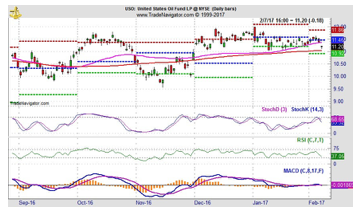This ETF is a play on the seasonal oil cycle.
United States Oil (USO)
from Stock Trader’s Almanac
Crude oil tends to bottom in mid-February and then rally through July with the bulk of the seasonal move ending in late April or early May. It is that early February low that can give traders an edge by buying ahead of a seasonally strong period. Going long crude oil’s July contract on or about February 14 and holding for approximately 60 days has been a profitable trade 27 times in 33 years, including the last three years straight, for an 81.8% win ratio with a cumulative profit of $108,660 (based upon trading a single crude oil futures contract excluding commissions and taxes).
Crude oil’s seasonal tendency to move higher in this time period is partly due to continuing demand for heating oil and diesel fuel in the northern states and partly due to the shutdown of refinery operations in order to switch production facilities from producing heating oil to reformulated unleaded gasoline in anticipation of heavy demand for the upcoming summer driving season. This has refiners buying crude oil in order to ramp up production for gasoline. Last year, crude bottomed in mid-February and that bottom was the end of crude’s multi-year bear market that began in earnest in 2014. The result was the second best performance in this trade’s history going back to 1984. Only 2008 was better.
Crude oil’s average price gain during its seasonally favorable period from mid-February to mid-May has been 9.3% since 1984. A similar move this year would lift crude from its current level around $52 per barrel to just over $56.80 per barrel over the next three months. Potential hurdles that could prevent this move are a strong U.S. dollar and stubbornly high global inventories. Catalysts for this move, and possibly more, are strong consumer confidence numbers and OPEC’s desire to regain pricing power. Geopolitical uncertainty could also provide a near-term lift to crude.
United States Oil (USO) is one choice from the ETF industry to implement this trade. USO is highly liquid trading in excess of 30 million shares daily and has net assets approaching $3 billion. Its stochastic, relative strength and MACD indicators are neutral to negative at this time as USO has been largely range bound since early December of last year. USO could be considered on dips below $11.10. If purchased, an initial stop loss of $9.75 is suggested. This stop loss is just below USO’s low close in November of last year.
Jeffrey A. Hirsch, Stock Trader’s Almanac, www.stocktradersalmanac.com, 800-762-2974, February 7, 2017
